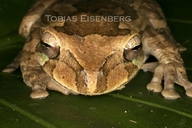|
Description
This is the largest tree frog native to the United States (Bartlett 1999). It is also the largest species in the genus (Duellman 1970).
Males are about 76 mm and females reach a maximum of 90 mm. Chubby, stocky and short-legged (Savage 2002).
Broad, flat head, indistinct from body. It is distinguished from other species by having a row of warts along the lower arm. Snout is rounded in dorsal view and bluntly truncate in lateral view. Large prominent eyes with horizontally ellipted pupils, and gold or silver irises. Distinct tympanum with a diameter about two-thirds of the eye. Dorsal skin is smooth and venter skin is granular (Lee 2000).
Varies in color and pattern. The upper surface of S. baudinii can be a shade of green, tan or brown with a pattern of dark patches. Metachrosis is extreme and individuals can change colors depending on circumstances (although individuals tend to retain their dark blotches usually outlined by black) (Savage 2002).
The vocal sac of breeding males is grey (Leenders 2001).
Males have dark throats and females have light throats (Bartlett 1999).
The undersurfaces are white to creamy yellow, usually devoid of markings (Lee 2000).
A dark streak extends from the eye onto the shoulder region. There is also a vertical black bar that lies on the upper lip directly below the eye (Norman 1998).
Similar to S. phaeota, the dorsal surface of the hind limbs have dark transverse bars (Leenders 2001).
Has contrasting yellow and black mottling on the back of the thighs and especially in groin region (Norman 1998).
Moderately large appendages. Toes are extensively webbed. Fingers are extensively webbed at bases (Savage 2002).
Distribution and Habitat
Country distribution from AmphibiaWeb's database: Belize, Costa Rica, El Salvador, Guatemala, Honduras, Mexico, Nicaragua, United States U.S. state distribution from AmphibiaWeb's database: Texas
Humid, subhumid and semiarid lowlands and marginally on premontane slopes from southern Sonora, Mexico, and extreme southeastern Texas to southeastern and southwestern Costa Rica (Savage 2002).
Probably more common in urban backyards with pools than in the wild. Occurs in the vicinity of canals, resacas, ponds, pools and other water retaining areas. In dry years these frogs are difficult to find (Bartlett 1999).Life History, Abundance, Activity, and Special Behaviors
Nocturnal and aboreal frog. Uses shallow temporary bodies of water as breeding sites (Savage 2002).
During dry seasons S. baudinii seeks refuge in tree holes, outer sheaths of banana plants, or under bark. When attacked by a predator, both sexes emit high-pitched distress calls with their mouths wide open (Savage 2002).
Usually breeds from June to October but in the more humid Caribbean lowlands, this frog appears to have a longer breeding season. (Duellman 1970). Males will usually call from the edge of water areas. Amplexus is axillary and takes place in the shallow waters. Females lay 2,500-3,500 eggs in a surface film. The eggs are black and cream in color and are 1.3 mm in diameter (1.5 mm including the vitelline membrane). Metamorphosis takes place 14-20 days after fertilization. Metamorphs are 12-15.5 mm in standard length (Savage 2002).
Their mating call consists of a series of short, explosive "wonk-wonk-wonk" notes. Call groups are spaced 15 seconds to several minutes apart. On average notes last 0.11 seconds. The two frequencies emphasized are from 350Hz and 2500Hz. S.baudinii call in duets (Duellman 1970).
One of a handful of frogs known to create cocoons of parchment like wrappings that cover themselves as a protective means to estivate during drought or dry seasons. (McDiarmid and Foster 1987). Trends and Threats
Although S. Baudinii seems to be able to adapt well to human impact, it is possible that development has reduced populations. Some historical peripheral populations have not been seen in a decade or more. This is a protected species by the state of Texas (Bartlett 1999). Possible reasons for amphibian decline Urbanization
References
Bartlett, R. D., and Bartlett, P. P. (1999). A Field Guide to Texas Reptiles and Amphibians. Gulf Publishing Company, Houston, Texas.
Duellman, W.E. (1970). The Hylid Frogs of Middle America. Monograph of the Museum of Natural History, University of Kansas.
Lee, J. C. (2000). A Field Guide to the Amphibians and Reptiles of the Maya World. Cornell University Press, Ithaca.
Leenders, T. (2001). A Guide to Amphibians And Reptiles of Costa Rica. Zona Tropical, Miami.
McDiarmid RW and Foster MS (1987). "Cocoon Formation in Another Hylid Frog, Smilisca baudinii." Journal of Herpetology, 21(4), 52-355. [link]
Norman, D. (1998). Common amphibians of Costa Rica. Privately published, Heredia, Costa Rica.
Savage, J. M. (2002). The Amphibians and Reptiles of Costa Rica:a herpetofauna between two continents, between two seas. University of Chicago Press, Chicago, Illinois, USA and London.
Originally submitted by: Veronica Garza (first posted 2004-05-07)
Edited by: Tate Tunstall, Michelle S. Koo (2023-01-02)Species Account Citation: AmphibiaWeb 2023 Smilisca baudinii: Common Mexican Treefrog <https://amphibiaweb.org/species/1164> University of California, Berkeley, CA, USA. Accessed Jun 13, 2025.
Feedback or comments about this page.
Citation: AmphibiaWeb. 2025. <https://amphibiaweb.org> University of California, Berkeley, CA, USA. Accessed 13 Jun 2025.
AmphibiaWeb's policy on data use.
| 